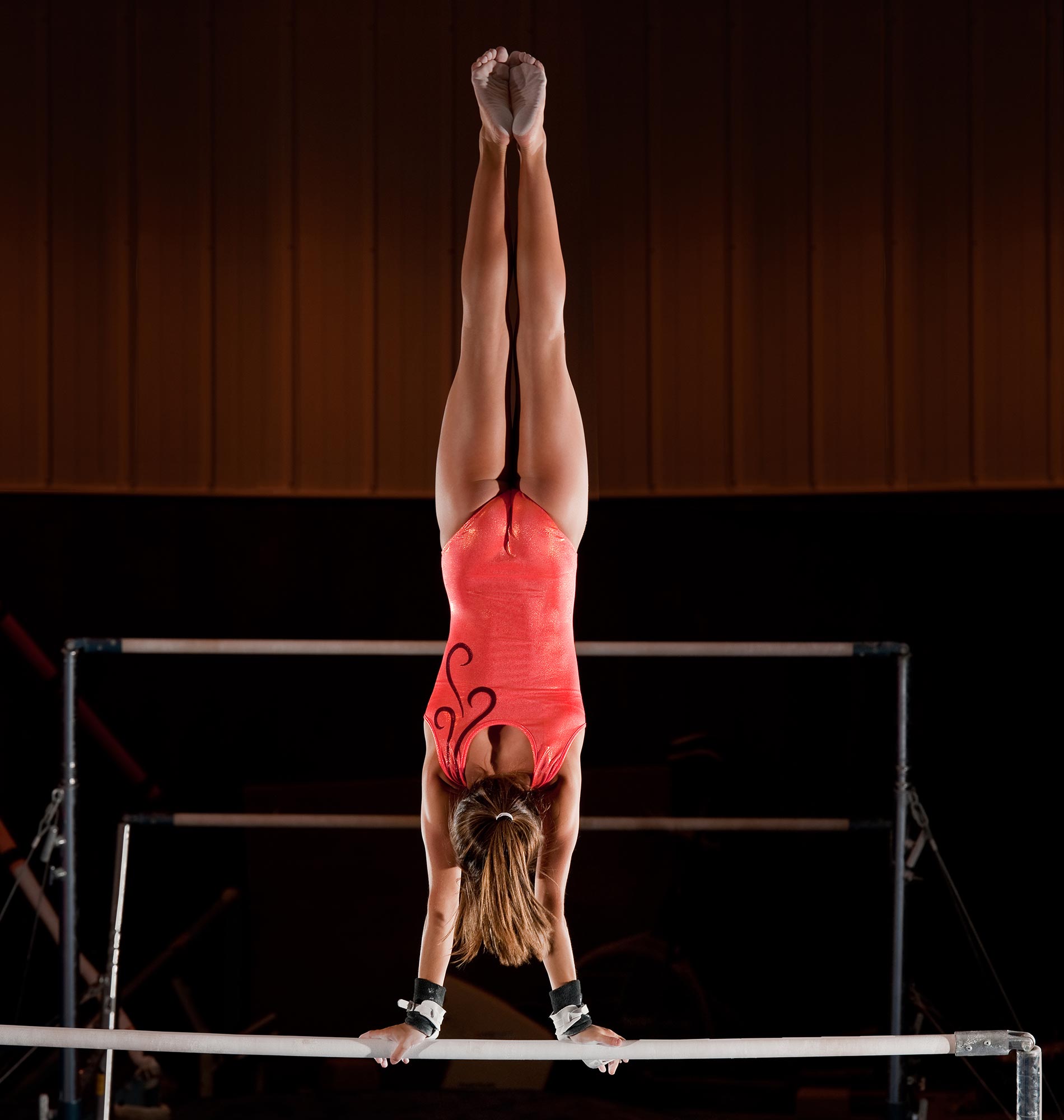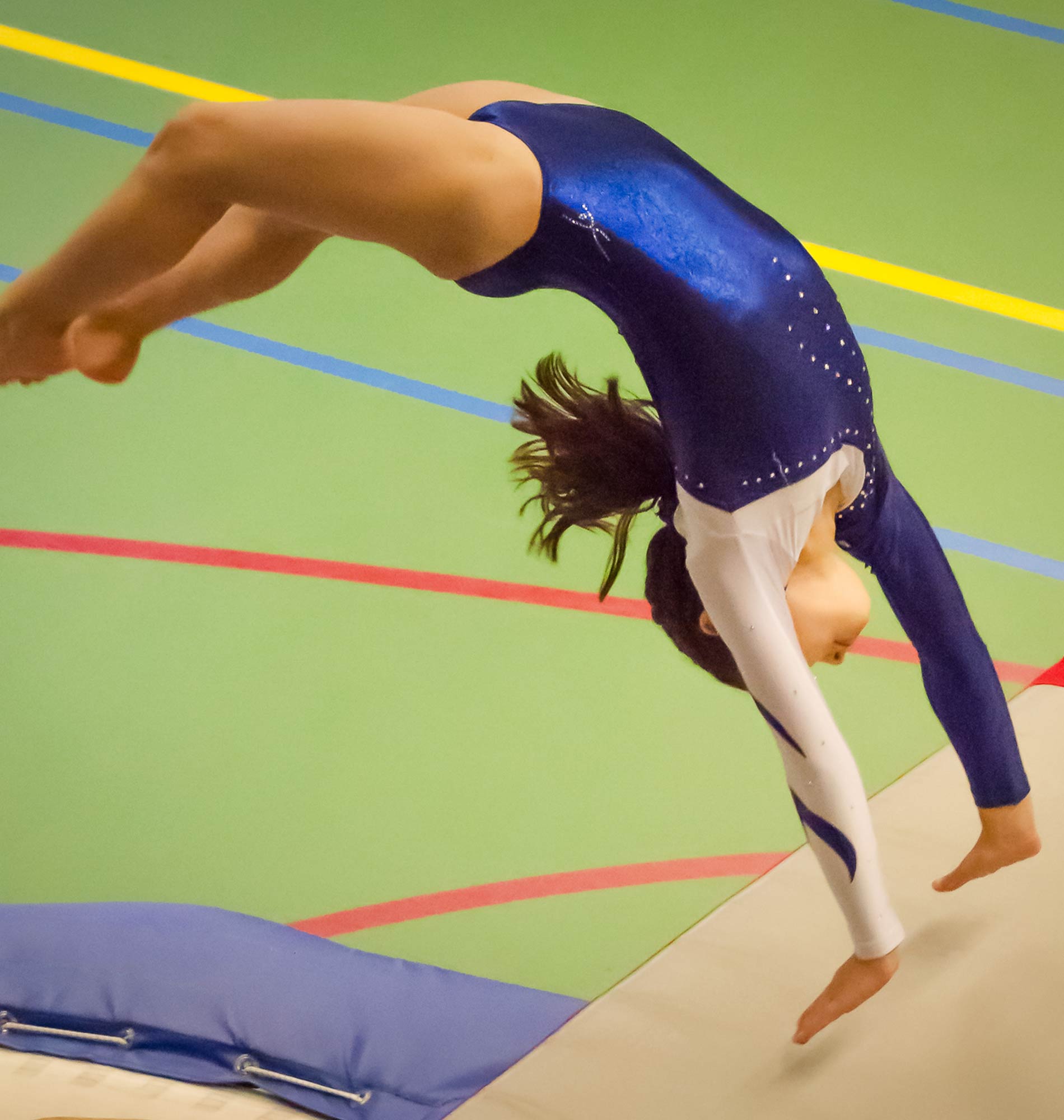1
Osteochondritis dissecans (OCD)
Epidemiology: Gymnasts with open growth plates (meaning they are still growing and have not yet finished puberty) are at risk for developing OCD.
Mechanism of Injury/Description: Osteochondritis dissecans (OCD) is a condition which can occur throughout the body (most commonly at the knee, elbow, and ankle) which occurs from repetitive impact/pounding or trauma on skeletally immature (meaning growing athletes). From repetitive impact/pounding on skeletally immature bone, this leads to a lack of blood flow to the bone and cartilage. In OCD, the proper nutrients needed to generate healthy bone growth are not reaching the affected area, causing more injury, pain, and possible breakage or small fragments of bone.
Signs/Symptoms: Gymnasts will complain of posterior lateral elbow pain in the capitellum. They may have mechanical signs and symptoms, resulting in the elbow feeling as if it is “catching” or “locking.” Gymnasts may also experience a loss of motion while flexing (bending) and extending (straightening) the elbow.
Diagnosis: The diagnosis of OCD is made by physical exam (pain to palpation/pushing on the capitellum, decreased range of motion, and a “locking” sensation) and imaging including X-rays (which show an OCD lesion), and an MRI (to confirm the diagnosis and stage the lesion).
Treatment: Depending on the severity of the OCD, the Medical Provider may prescribe non-surgical or surgical treatment. Non-surgical treatment typically requires bracing, physical therapy, and anywhere between 3-9 months of rest. Surgical treatment is needed if the OCD is unstable and will not heal on its own.
Prevention: Focusing on posture and strengthening, as well as avoiding hyperextension of the elbow and limiting repetitions are important in preventing OCD lesions.
Gymnastics Medical Provider PEARLS: OCD lesions can be seen on x-ray but it is important to also perform an MRI to stage the lesion as this will help determine if surgical or non-surgical intervention is needed.
Gymnast, Parent, and Coach PEARLS: Do NOT ignore elbow pain or decreased elbow motion. These could be warning signs that your gymnast has OCD.
1
Osteochondritis dissecans (OCD)
Epidemiology: Gymnasts with open growth plates (meaning they are still growing and have not yet finished puberty) are at risk for developing OCD.
Mechanism of Injury/Description: Osteochondritis dissecans (OCD) is a condition which can occur throughout the body (most commonly at the knee, elbow, and ankle) which occurs from repetitive impact/pounding or trauma on skeletally immature (meaning growing athletes). From repetitive impact/pounding on skeletally immature bone, this leads to a lack of blood flow to the bone and cartilage. In OCD, the proper nutrients needed to generate healthy bone growth are not reaching the affected area, causing more injury, pain, and possible breakage or small fragments of bone.
Signs/Symptoms: Gymnasts will complain of posterior lateral elbow pain in the capitellum. They may have mechanical signs and symptoms, resulting in the elbow feeling as if it is “catching” or “locking.” Gymnasts may also experience a loss of motion while flexing (bending) and extending (straightening) the elbow.
Diagnosis: The diagnosis of OCD is made by physical exam (pain to palpation/pushing on the capitellum, decreased range of motion, and a “locking” sensation) and imaging including X-rays (which show an OCD lesion), and an MRI (to confirm the diagnosis and stage the lesion).
Treatment: Depending on the severity of the OCD, the Medical Provider may prescribe non-surgical or surgical treatment. Non-surgical treatment typically requires bracing, physical therapy, and anywhere between 3-9 months of rest. Surgical treatment is needed if the OCD is unstable and will not heal on its own.
Prevention: Focusing on posture and strengthening, as well as avoiding hyperextension of the elbow and limiting repetitions are important in preventing OCD lesions.
Gymnastics Medical Provider PEARLS: OCD lesions can be seen on x-ray but it is important to also perform an MRI to stage the lesion as this will help determine if surgical or non-surgical intervention is needed.
Gymnast, Parent, and Coach PEARLS: Do NOT ignore elbow pain or decreased elbow motion. These could be warning signs that your gymnast has OCD.
2
Ulnar Collateral Ligament (UCL) Tear/Sprain
Epidemiology: The ulnar collateral ligament (UCL) is located on the “pinky side” of your elbow and provides stability to the joint. It is commonly injured in baseball athletes, but can also be torn or sprained in gymnasts.
Mechanism of Injury/Description: A rapid valgus force (a force that causes the elbow to open up on the inside of the joint) causes a tear or sprain to the UCL.
Signs/Symptoms: Athletes will have pain on the inside (ulnar) aspect of the elbow. They may have a pop or snap in the elbow at the time of injury. They may have a positive milling maneuver and positive valgus stress test.
Diagnosis: The Medical Provider will do a physical exam of the UCL which will include palpating (pushing) on the elbow, looking at elbow motion, and stressing the UCL (valgus stress test determining if there is an end point). An MRI or ultrasound can confirm a UCL tear or sprain (because this is a ligament injury you will not be able to see this tear/sprain on x-ray but you could see loose bodies or calcifications of UCL depending on the severity and length of pain).
Treatment: The treatment of a UCL injury depends on the severity of the injury. A sprain will heal with rest, brace, and PT but a full tear often needs surgery (Ex: Tommy John’s surgery).
Prevention: To prevent UCL injuries, gymnasts should avoid hyperextending their elbows to prevent valgus collapse by working on their posture, shoulder/thoracic mobility, and periscapular strength.
Gymnastics Medical Provider PEARLS: Consider ordering a 3T elbow MRI or arthrogram study for more detail/clarity on the UCL injury. Differential diagnosis for medial elbow pain should include Medial epicondylitis, Flexor-pronator strain, Ulnar neuropathy, and Valgus extension overload.
Gymnast, Parent, and Coach PEARLS: If a gymnast is experiencing elbow pain go see a medical provider. A UCL injury previously was thought to be career ending but now with surgical intervention the return to sports rate has increased.
3
“Little League Elbow”
Medial Epicondyle Apophysitis
Epidemiology: This injury occurs in gymnasts with open growth plates (they are still growing and have not yet finished puberty).
Mechanism of Injury/Description: Repetitive tugging and pulling on the growth plate where the wrist flexors (muscles that bend your wrist down in flexion) attach can lead to irritation/inflammation of the medial epicondyle growth plate.
Signs/Symptoms: Gymnasts will report pain on the medial (inside portion) of the elbow, have instability and pain with a valgus stress test.
Diagnosis: The Medical Provider will do a physical exam which includes palpating (pushing) on the medial epicondyle which causes pain, and the gymnast may have pain with resisted wrist flexion. X-rays are typically helpful in the diagnosis (showing widening at the medial epicondyle growth plate), and occasionally, an MRI may be needed (to confirm the diagnosis or rule out other elbow injury.
Treatment: Rest, anti-inflammatory medication, bracing and physical therapy are often used to help treat medial epicondyle apophysitis. Occasionally, an injection may be helpful in decreasing pain and inflammation.
Prevention: Posture correction, periscapular and rotator cuff strengthening, wrist strengthening, and limiting number of impacts on the arms can help prevent medial epicondyle apophysitis.
Gymnastics Medical Provider PEARLS: There are three potential sites of injury for this: medial epicondyle stress fractures, ulnar collateral ligament (UCL), and flexor-pronator mass strains. This is more commonly described in throwing athletes but is also seen in gymnasts.
Gymnast, Parent, and Coach PEARLS: If a gymnast is experiencing elbow pain go see a medical provider.
4
Elbow Dislocation
Epidemiology: An elbow dislocation can occur in gymnasts at any age.
Mechanism of Injury/Description: Falling or landing on the arm (FOOSH – fall on an outstretched hand) can cause an elbow dislocation.
Signs/Symptoms: Immediate pain and deformity with a feeling of the elbow “not in place” will occur in a dislocation. Some athletes also have numbness in tingling in the arm.
Diagnosis: An elbow dislocation is typically diagnosed by physical exam. An x-ray is typically performed and an MRI may also be needed if the Medical Provider is concerned about other structures in the elbow.
Treatment: In a true dislocation, the athlete will need immediate medical attention to have the elbow reduced “put back into place”. A brace or splint is used for a short time period and physical therapy will also be needed.
Prevention: Teaching gymnasts to land safely without putting their hands out can help to prevent elbow dislocations.
Gymnastics Medical Provider PEARLS: If you are providing on site gymnastics medical coverage you should be familiar with relocating elbows and shoulders. Also, have an Emergency Action Plan (EAP) in place as well as know where your closest hospital is.
Gymnast, Parent, and Coach PEARLS: Teaching gymnasts to land safely and not with their arms out in front can be crucial in decreasing the number of elbow dislocations and fractures.

